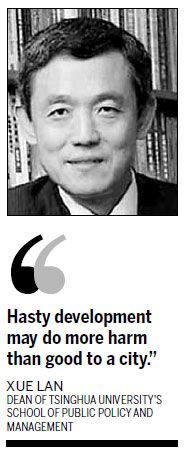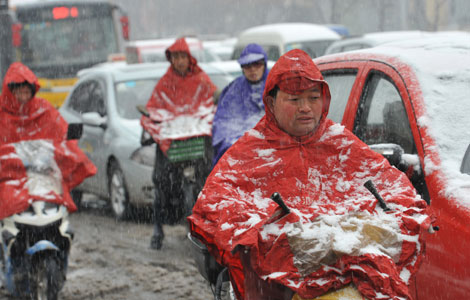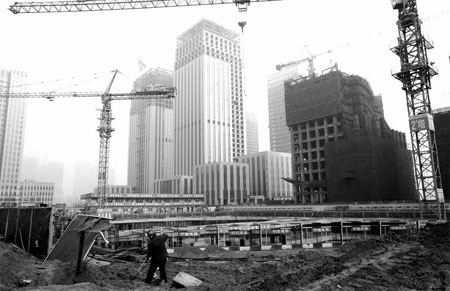Are cities expanding too fast and too soon?
Updated: 2013-04-23 08:07
By Xue Lan (China Daily)
|
||||||||
|
Construction of a business district in Tianjin. As Chinese cities compete with each other to become the latest global city, some experts question whether such expensive development is needed and cost-effective. Provided to China Daily |

Editor's Note: A great deal of hope has been invested in the role urbanization can play in helping to drive the nation's next cycle of economic boom. But how can China manage what no other country has ever achieved before, to build so many urban communities in such a short space of time?
To do things right, Premier Li Keqiang recently said that China will have to learn from other nations' experiences. Now Professor Xue Lan, dean of Tsinghua University's School of Public Policy and Management, joins the discussion by sharing his concerns and reporting his observations.
China's urbanites outnumbered its rural residents for the first time in history in 2011 and keep increasing steadily. With this achievement, urbanization has become a hot topic that many hope can be a new engine for economic growth.
However, without serious solutions to address the unprecedented challenges facing Chinese cities, these great aspirations may come unstuck, as this high-speed urbanization is partly powered by certain distorted mechanisms.
First-tier cities or not, many urban centers in China share the ambition of becoming international, national or regional metropolises, playing the role of financial, industrial or cultural centers. Accordingly, their planning, infrastructure and population have all scaled up, leading to a greater need for investment.
But does a country need so many financial, industrial or cultural centers? This lack of provident planning has increased the danger of vicious competition for investment and the risk of a waste of resources.
Smart plans
Planning authorities may gain wisdom from the experience of cities in other countries.
For example, Santa Barbara, a small but beautiful city in California, gives a holistic and peaceful impression. Anybody who has flown to that city from China must have been impressed by the simplicity of its airport, for in China, regardless of the size of the city, it has to construct a grand airport if it is to have one.
The harmony and pragmatism demonstrated in Santa Barbara's city planning is very much needed in China's urbanization, if China is to have fewer stereotyped cities and minimize the waste of resources.
Also, opportunities for industries to thrive are never reserved exclusively for metropolises. The headquarters of Hallmark Cards, the largest manufacturer of greeting cards in the United States, is located in Kansas City, Missouri. Starting from this less well-known city in the midwestern US, Hallmark cards are now sold all over the world, and the company has consolidated annual revenue of around $4 billion.
Hallmark Cards was not based on depending on one city for all its resources and convenience, but on the pursuit of excellence, and keeping its research and development center there. Pursuit of excellence is part of the city's culture, which has also greatly benefited a lot of other companies.
Other than the poorly conceived and potentially wasteful plans, local governments in China also have problems in their hasty moves to promote urbanization. Projects that take decades to complete in other countries are often finished in four or five years.
No haste
Harvard University initiated a plan for campus expansion 10 years ago, when Larry Summers was still its president. To construct new teaching and research buildings on the other side of the Charles River, the university went through several rounds of communication with faculty, students and local residents, and even set up an exhibition room to present its plan to the public.
But still, the construction may take another 10 years or longer before it can be accomplished. While Harvard was in the process of communication, hundreds of universities in China have established brand-new campuses and even university towns.
These hasty developments, while reflecting local government officials' eagerness to contribute to the modernization of our country, also reveal the limits of their terms of office. Every official wants to present a good record when their terms of office are over so as to lay the foundation for their next steps. The pace of urbanization, however, is not necessarily in step with the officials' terms.
As a result, quality problems, like those revealed in recent extreme weather in a lot of Chinese cities, are beginning to emerge. What's worse, the negative results are far from being fully discovered, as the cities' incumbent leaders are usually reluctant to expose anything negative about their predecessors, who are in most cases their current bosses.
A problem related to the change of officials is the change of policies. Very often in China, transitions of government officials also bring about transitions of ideas and policies. Although it is necessary for policies to evolve as society develops, changes, if too frequent, only suggest that the existing policies are not forward-looking enough.
In Charleston, South Carolina, the setting of Gone with the Wind, many historical buildings from the colonial era remain well preserved today, as Mayor Joseph Riley's life's pursuit is to protect the historical buildings and preserve the city's history and culture.
It's perhaps not a coincidence that he is one of the longest serving mayors that is still in office - he has served 10 terms starting from 1975. When I was invited to Charleston by the Board of the Brookings Institution, Riley was our luncheon speaker. With his soft southern accent and beautiful PowerPoint slides, he spoke on and on, for over an hour, long exceeding the appointed time, until the moderator had to stop him.
The next day, when the governor of South Carolina asked me about my impressions of Charleston, I mentioned Riley's presentation. Immediately the governor asked: "Did he finish it?" We both laughed. Behind Riley's unfinished presentation was his genuine love for the city and persistence in protecting it, which can be a great source of learning for Chinese officials.
To advance urbanization with good Chinese characteristics, the planning authorities should first learn to sort out priorities and make hard choices. Since we cannot do everything and do it well, we had better make choices in accordance with cities' advantages. Only by choosing priorities and continuing its development can a city distinguish itself.
The next thing to do is to slow down. It takes time for contemporary trends to become cultural assets, and for experience to become invaluable learning. It also takes time for problems and conflicts to be exposed, and then, to be resolved. Hasty development may do more harm than good to a city.
Sustainability needed
Vital importance should be attached to sustainability in China's urbanization drive - sustainability both in terms of the environment, and of the system. Environment deterioration is affecting not only major cities, but also many medium and small cities in China. If the nation's urbanization does not develop in a sustainable way, it could bring more problems and even disasters to future generations.
Meanwhile, sustainability in urban governance is also important. For example, not enough attention is paid to the public finance system. Without a healthy public finance system, urbanization will create more problems than it solves.
It is estimated that thousands of millions of rural residents will become urbanites in the decades to come. It is the mission of our generation to make hard choices, slow down our pace, and achieve sustainability, to ensure the healthy development of China's urbanization.
Xue Lan is also co-chair of the Urban China Initiative jointly led by the Tsinghua School of Public Policy and Management, Columbia University, and McKinsey & Company.
(China Daily 04/23/2013 page17)

 Obama celebrates young inventors at science fair
Obama celebrates young inventors at science fair
 Earth Day marked around the world
Earth Day marked around the world
 Volunteer team helping students find sense of normalcy
Volunteer team helping students find sense of normalcy
 Ethnic groups quick to join rescue efforts
Ethnic groups quick to join rescue efforts
 Earthquake leaves family shattered
Earthquake leaves family shattered
 Boston Marathon bombing suspect charged
Boston Marathon bombing suspect charged
 Chasing vestiges of the Great Wall
Chasing vestiges of the Great Wall
 Weekly Photos: April 15-21
Weekly Photos: April 15-21
Most Viewed
Editor's Picks

|

|

|

|

|

|
Today's Top News
Russia criticizes US reports on human rights
China 'aims to share its dream with world'
Chinese president appoints 5 new ambassadors
Nation's IPR suits see spike in 2012
H7N9 not spread between humans: WHO
Health new priority for quake zone
Sino-US shared interests emphasized
China, ROK criticize visits to shrine
US Weekly

|

|







